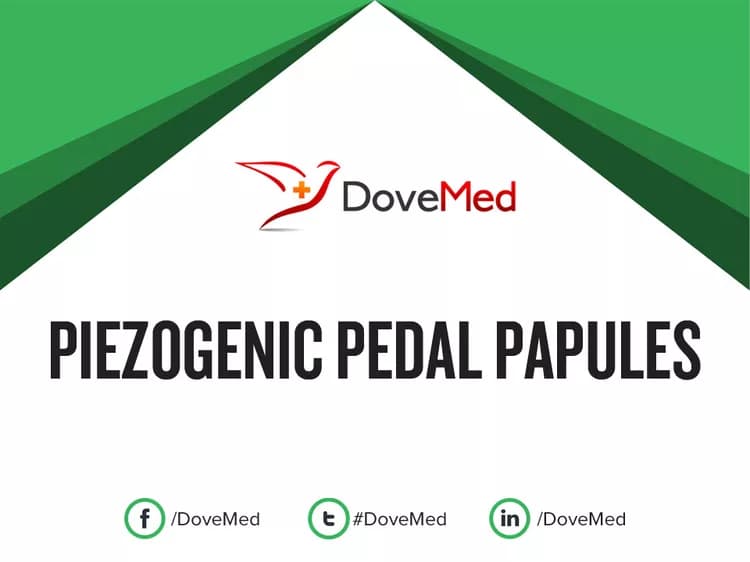What are the other Names for this Condition? (Also known as/Synonyms)
- Piezogenic Papules of Feet
- Piezogenic Papules of Heel
What is Piezogenic Pedal Papules? (Definition/Background Information)
- Piezogenic Pedal Papules is a common, benign papule of the soft tissue, which can occur in the heels
- The term ‘piezogenic’ means occurring due to pressure; and ‘papules’ are small, well-defined (with clear borders), discolored, raised skin bumps
- In a majority of the cases, single papules are observed on the feet; though rarely, it may occur as multiple papules too
- The risk factors for Piezogenic Pedal Papules include Ehler-Danlos syndrome, Prader-Willi syndrome, flatfeet, and obesity. However, the cause of the condition is unknown
- A complete surgical excision of Piezogenic Pedal Papule is considered curative. The prognosis of the skin papule is excellent on its complete surgical removal
Who gets Piezogenic Pedal Papules? (Age and Sex Distribution)
- Piezogenic Pedal Papules can occur during all stages of life, though It usually occurs at middle age
- It is more common in females than in males, though both are affected
- Those who engage in activities with high impact on feet, such as distance running, figure skating, and others
- The condition is observed worldwide, and no geographical localization has been reported
- There is also no ethnic or racial preference for the condition
What are the Risk Factors for Piezogenic Pedal Papules? (Predisposing Factors)
The risk factors for Piezogenic Pedal Papules include:
- Ehler-Danlos syndrome
- Prader-Willi syndrome
- Flatfeet
- Performing excessive weight-bearing exercises or participating in similar sports
- Being overweight or obese (obese women are particularly at risk)
- Rigorous physical activity
- Occupations that involve a lot of standing and walking
It is important to note that having a risk factor does not mean that one will get the condition. A risk factor increases ones chances of getting a condition compared to an individual without the risk factors. Some risk factors are more important than others.
Also, not having a risk factor does not mean that an individual will not get the condition. It is always important to discuss the effect of risk factors with your healthcare provider.
What are the Causes of Piezogenic Pedal Papules? (Etiology)
- The cause of Piezogenic Pedal Papules is presently unknown
- It is thought to be due to herniation of fat through the dermis of the skin
- Piezogenic Pedal Papules do not usually run within families
What are the Signs and Symptoms of Piezogenic Pedal Papules?
Most Piezogenic Pedal Papules are asymptomatic, and no specific signs and symptoms may be observed. However, in others, a wide-range of presentations may be noted such as:
- Usually, the presence of a solitary papule under the skin is noticed. Rarely, the papule can occur as multiple papules too
- They are typically less than 1 cm in size (along the larger dimension)
- The papules usually occur in the subcutaneous tissue in the heels, and it may occasionally affect both feet (bilateral presentation)
- The papular mass on skin may be occasionally painful
The timing of the signs and symptoms are important to determine the type of papule. Piezogenic Pedal Papules develop steadily over weeks to months.
How is Piezogenic Pedal Papules Diagnosed?
The following are the diagnostic tools for Piezogenic Pedal Papules:
- A thorough physical examination and a complete medical history are very crucial
- Awareness of the condition and examination of the feet both elevated and weight bearing will often suffice
- Dermoscopy: Dermoscopy is a diagnostic tool where a dermatologist examines the skin, using a special magnified lens
- Tissue biopsy of the papule: A tissue biopsy is performed and sent to a laboratory for a pathological examination, who examines the biopsy under a microscope. After putting together clinical findings, special studies on tissues (if needed) and with microscope findings, the pathologist arrives at a definitive diagnosis
- Sometimes, the pathologist may perform special studies, which may include immunohistochemical stains, histochemical stains, molecular testing, and very rarely, electron microscopic studies. Examination of the biopsy under a microscope by a pathologist is considered to be gold-standard in arriving at a conclusive diagnosis
- Differential diagnosis, to eliminate other papule types are often considered, before arriving at a definitive diagnosis
Many clinical conditions may have similar signs and symptoms. Your healthcare provider may perform additional tests to rule out other clinical conditions to arrive at a definitive diagnosis.
What are the possible Complications of Piezogenic Pedal Papules?
There are no reports of any significant complications developing from Piezogenic Pedal Papules.
How is Piezogenic Pedal Papules Treated?
In most cases, no treatment is necessary for Piezogenic Pedal Papules, since they are self-limiting and asymptomatic. A complete regression of the papules may also take place.
When required, the following methods may be effectively considered in their treatment:
- Steroid injection at papule site
- Weight reduction (in case of obesity)
- Decreasing weight-bearing exercises
- Providing support arches for flatfeet
- The use of compression stockings
- Surgical treatment:
- Surgical procedures may be adopted only if non-surgical measures are unsuccessful
- A complete surgical excision of the papule is generally considered curative
In case no surgery is required, the patient may be reassured that Piezogenic Pedal Papules are benign lesions.
How can Piezogenic Pedal Papules be Prevented?
Eliminating the modifiable risk factors helps in the prevention of Piezogenic Pedal Papules. These may include:
- Reduce weight-bearing exercises
- Decrease weight (if obese or overweight)
- Provide support for flatfeet
What is the Prognosis of Piezogenic Pedal Papules? (Outcomes/Resolutions)
The prognosis of Piezogenic Pedal Papules is excellent with appropriate treatment.
Additional and Relevant Useful Information for Piezogenic Pedal Papules:
The following DoveMed website link is a useful resource for additional information:
Related Articles
Test Your Knowledge
Asked by users
Related Centers
Related Specialties
Related Physicians
Related Procedures
Related Resources
Join DoveHubs
and connect with fellow professionals



0 Comments
Please log in to post a comment.